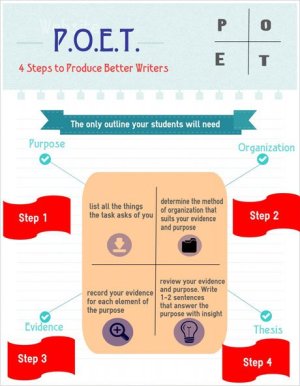4 Steps to Better Writers
Clarity. It is what we long for when we travel through a student's essay. Yet our struggling writers make us wander through a cluttered maze of thoughts, leading to dead ends.
We want an awareness of purpose. We want ideas to progress in logical order. We want sentences to be fluid and confident, not stuffed with words desperate to impress. We want so much because good writing is multidimensional. So how to encourage this? Rubrics are uninspiring and often contain too much information for students to digest. The question remains: how do we give students guidelines without glutting their minds with a 50-item checklist?
A few years ago I had a Steve Jobs infatuation. I had my first iPhone, I was typing away on my Macbook Pro, and I was reading Walter Issacson's biography of Jobs. One passage resonated with me because it encapsulated what I admired about him. When developing the first iPod, Jobs wanted users to hold 1,000 songs in their pocket. He challenged his engineers to get everyone to a song in four clicks. Any more, he felt, would be too much.
Only when you consider where we were can you appreciate this accomplishment. Before the iPod, we were carrying Discmen. We were limited to one CD at a time. And carrying 1,000 songs would require us to lug a massive album of CDs, equivalent to the heftiest of college textbooks. The iPod changed it all.
It got me thinking about a theory of four. Could I boil down the many facets of writing to four essential steps? To achieve this, I went through ten years worth of AP exams and high-level models looking for common threads. I wanted to isolate the things that good writers do repeatedly.

I came up with POET, a simple and effective pre-writing strategy for your students.
P = Purpose
Every strong essay had an unwavering commitment to the purpose. Weak essays deviated from purpose, often veering down the path of plot summary. I now have students underline and record the verbs of the prompt (analyze the relationship, connect the devices, distinguish between) to fully grasp their purpose. Every sentence written must relate to it.
O = Organization
The best essays have a system of organization. They possess a deliberate and pre-ordained plan of progress. Their body paragraphs develop in one of the following ways:
- Chronologically: from the beginning of the piece to the end.
- Cause and effect: showing the techniques an author used and the effects they created.
- General to specific: look broadly through a telescope, then focus under a microscope, noticing the small details contributing to the big picture.
- Compare and contrast: start with what unites works and move to appreciating differences between them.
E = Evidence
Weak essays make claims -- and that's it. They leave the reader unfulfilled because they neglect the evidence needed to substantiate those claims. Well-written essays have an abundance of evidence in their body paragraphs. Have students list all evidence before they write.
T = Thesis (with insight)
Repeating the prompt is the refuge of students that lack either originality or confidence. They are afraid that their opinion is wrong, so they just state what's given. To avoid this, I challenge students to answer the question "with insight." My challenge is asking them what they infer, what they perceive. Modeling is essential, and here's a good example of the difference:
- Prompt: In the following poem by Sir Philip Sidney (1554-1586), the speaker addresses the subject of desire. Write a well-developed essay in which you analyze how poetic devices help to convey the speaker's complex attitude toward desire (from the 2012 AP exam).
- Weak thesis: The speaker of "Thou Blind Man's Mark" uses a myriad of poetic devices such as diction, repetition and periodic structure to express its complex attitude toward desire.
This thesis offers a laundry list of devices and fails to state what is complex as well as the speaker's attitude toward desire. It fails to answer the prompt with insight and, unsurprisingly, it scored a 4 out of 9. - Strong thesis: The speaker's contempt for desire is clearly portrayed in his harsh description and the effect it has on him, as well as his declaration that he will no longer yield to its power.
This thesis is insightful because it understands desire (contempt for it), tone (harsh description) and addresses complexity (his declaration that he will no longer yield to its power). This essay scored a 9 of 9.
Sure, there are things that this outline leaves out. It says nothing of effective transitions. It overlooks sentence variety. But if students do these four things well, they will be in good shape.
Last year when I implemented this strategy, scores improved drastically. There was a 17 percent spike in students earning a 3 or better on the AP exam because I repeatedly asked them to "be POETs" before they wrote. Maybe one year is not enough to be conclusive. Time will tell. But I like how this is a manageable approach for getting students to consistently do four essential elements of effective writing.
